Parallel Comparison of Major Sudden Stratospheric Warming Events in CESM1-WACCM and CESM2-WACCM
Abstract
1. Introduction
2. Data and Methods
2.1. Model Data and Reanalysis
2.2. Methods
3. Comparison of SSW Events in CESM1-WACCM and CESM2-WACCM
3.1. Statistics of Vortex Displacement and Split SSWs
3.2. Evolution of the Stratospheric Circulation and Temperature during Vortex Displacement and Split SSWs
3.3. Evolution of Tropospheric Circulation during Vortex Displacement and Split SSWs
3.4. Teleconnections and Upward Propagation of Planetary Waves from the Troposphere
3.5. Downward Impact of SSW
4. Summary and Discussion
- SSW events are searched and their displacement and split types are categorized using the WMO definition [43] and a threshold-based classification method by Seviour et al. [18], respectively. It is found that the ratio of vortex displacement to split SSWs is about 0.79 in the JRA55 reanalysis while the ratio is 1.2–1.4 in the CESM1-WACCM and CESM2-WACCM models, which means that the CESM-WACCM model family tends to simulate more vortex displacement SSWs than in the reanalysis. The seasonal distribution somewhat differs between two types of SSW events in observations. The frequency of both SSW types peaks in January. November is the wintertime month when least SSWs occur for both types. Although CESM2-WACCM is expected to improve over CESM1-WACCM, no statistical proof is found that the seasonal distributions of both SSW types are simulated better by CESM2-WACCM than CESSM1-WACCM.
- The decadal frequency of both types of SSW events changes quasi-periodically in both the reanalysis and the models, which may reflect the internal variability of the stratosphere. All datasets show that a low/high frequency of vortex split SSWs tends to be accompanied by a high/low frequency of vortex displacement SSWs. Due to the atmospheric chaos and the free run of the atmosphere-ocean system in historical experiments of both models, the numbers of SSW events in each decade are very different in model and the reanalysis.
- The polar temperature anomalies, height anomalies, wind anomalies, and eddy heat flux anomalies for vortex split SSWs are identified to be stronger and more persistent than those for vortex displacement SSWs in the reanalysis. In contrast, as the sample size becomes large in the models, and the differences between vortex displacement and split SSWs are smaller than in JRA55. The circulation and temperature anomalies in CESM1-WACCM more resemble JRA55 quantitatively, and the anomaly amplitudes in CESM2-WACCM are underestimated due to the worse phase locking of SSWs from CESM2-WACCM. Although the total eddy heat flux by all waves before vortex split SSWs are much stronger than displacement SSWs in JRA55, such differences between two types of SSWs in models are small.
- It is shown in both observations and the models that positive PNA and negative WP patterns in the troposphere precedes vortex displacement and split SSWs, which indicates the enhancement of upward planetary waves from the troposphere before SSW events. The North Pacific low anomaly center is much stronger than the North Atlantic counterpart before and during the displacement SSWs, which mainly projects onto an enhanced wavenumber-1. In contrast, the North Pacific and North Atlantic low anomaly centers before and during split SSWs are comparable, which corresponds to an enhanced wavenumber-2. In addition, as in JRA55, the models also show that negative NAO-like pattern after split SSW onset is stronger than that after displacement SSW onset.
- A cold Eurasian continent–warm North American continent pattern appears during some pre-SSW periods for both types of SSWs. On the contrary, a warm Eurasian continent–cold North American continent pattern appears after the displacement SSW onset. In contrast, both continents are anomalously cold after the split SSW onset. The near-surface air temperature patterns before and after the SSW onset are well reproduced by both models, although the temperature anomalies after the split SSW onset in CESM2-WACCM are somewhat underestimated.
Author Contributions
Funding
Acknowledgments
Conflicts of Interest
References
- O’Neill, A.; Charlton-Perez, A.J.; Polvani, L.M. Stratospheric sudden warmings. In Encyclopedia of Atmospheric Science, 2nd ed.; North, G.R., Pyle, J., Zhang, F., Eds.; Elsevier: London, UK, 2014; Volume 4, pp. 30–40. [Google Scholar]
- Limpasuvan, V.; Thompson, D.W.J.; Hartmann, D.L. The life cycle of the Northern Hemisphere sudden stratospheric warmings. J. Clim. 2004, 17, 2584–2596. [Google Scholar] [CrossRef]
- Manney, G.L.; Krnney, G.; Sabutis, J.L.; Sena, S.A.; Pawson, S. The remarkable 2003–2004 winter and other recent warm winters in the Arctic stratosphere since the late 1990s. J. Geophys. Res. 2005, 110, 583–595. [Google Scholar] [CrossRef]
- Charlton, A.J.; Polvani, L.M. A new look at stratospheric sudden warmings. Part I: Climatology and modeling benchmarks. J. Clim. 2007, 20, 449–469. [Google Scholar] [CrossRef]
- Scherhag, R. Die explosionsartigen Stratospherenerwarmingen des Spatwinters, 1951–1952. Ber. Deut. Wetterd. (U.S. Zone) 1952, 6, 51–63. [Google Scholar]
- Matsuno, T. A dynamical model of the stratospheric sudden warming. J. Atmos. Sci. 1971, 28, 1479–1494. [Google Scholar] [CrossRef]
- McIntyre, M.E. How well do we understand the dynamics of stratospheric warming? J. Meteorol. Soc. Jpn. 1982, 60, 37–64. [Google Scholar] [CrossRef]
- Limpasuvan, V.; Hartmann, D.L. Eddies and the annular modes of climate variability. Geophys. Res. Lett. 1999, 26, 3133–3136. [Google Scholar] [CrossRef]
- Black, R.X. Stratospheric forcing of surface climate in the Arctic Oscillation. J. Clim. 2002, 15, 268–277. [Google Scholar] [CrossRef]
- Kim, Y.J.; Flatau, M. Hindcasting the January 2009 Arctic sudden stratospheric warming and its influence on the Arctic Oscillation with unified parameterization of orographic drag in NOGAPS. Part I: Extended-range stand-alone forecast. Weather Forecast. 2010, 25, 1628–1644. [Google Scholar] [CrossRef]
- Rao, J.; Ren, R.; Chen, H.; Yu, Y.; Zhou, Y. The stratospheric sudden warming event in February 2018 and its prediction by a climate system model. J. Geophys. Res. Atmos. 2018, 123, 13332–13345. [Google Scholar] [CrossRef]
- Mukougawa, H.; Sakai, H.; Hirooka, T. High sensitivity to the initial condition for the prediction of stratospheric sudden warming. Geophys. Res. Lett. 2005, 32, L08814. [Google Scholar] [CrossRef]
- Mitchell, D.M.; Gray, L.J.; Anstey, J.; Baldwin, M.P.; Charlton-Perez, A.J. The Influence of Stratospheric Vortex Displacements and Splits on Surface Climate. J. Clim. 2013, 26, 2668–2682. [Google Scholar] [CrossRef]
- Seviour, W.J.M.; Mitchell, D.M.; Gray, L.J. A practical method to identify displaced and split stratospheric polar vortex events. Geophys. Res. Lett. 2013, 40, 5268–5273. [Google Scholar] [CrossRef]
- Nakagawa, K.I.; Yamazaki, K. What kind of stratospheric sudden warming propagates to the troposphere? Geophys. Res. Lett. 2006, 33, L04801. [Google Scholar] [CrossRef]
- Maycock, A.C.; Hitchcock, P. Do split and displacement sudden stratospheric warmings have different annular mode signatures? Geophys. Res. Lett. 2015, 42, 10943–10951. [Google Scholar] [CrossRef]
- O’Callaghan, A.; Joshi, M.; Stevens, D.; Mitchell, D. The effects of different sudden stratospheric warming types on the ocean. Geophys. Res. Lett. 2014, 41, 7739–7745. [Google Scholar] [CrossRef]
- Seviour, W.J.M.; Gray, L.J.; Mitchell, D.M. Stratospheric polar vortex splits and displacements in the high-top CMIP5 climate models. J. Geophys. Res. 2016, 121, 1400–1413. [Google Scholar] [CrossRef]
- Rao, J.; Ren, R.; Chen, H.; Liu, X.; Yu, Y.; Yang, Y. Sub-seasonal to seasonal hindcasts of stratospheric sudden warming by BCC_CSM1.1(m): A comparison with ECMWF. Adv. Atmos. Sci. 2019, 35, 479–494. [Google Scholar] [CrossRef]
- Rao, J.; Ren, R. Varying stratospheric responses to tropical Atlantic SST forcing from early to late winter. Clim. Dyn. 2018, 51, 2079–2096. [Google Scholar] [CrossRef]
- Yoden, S.; Yamaga, T.; Pawson, S.; Langematz, U. A composite analysis of the stratospheric sudden warmings simulated in a perpetual January integration of the Berlin TSM GCM. J. Meteorol. Soc. Japan 1999, 77, 431–445. [Google Scholar] [CrossRef]
- Holton, J.R.; Tan, H.C. The Influence of the equatorial quasi-biennial oscillation on the global circulation at 50mb. J. Atmos. Sci. 1980, 37, 2200–2208. [Google Scholar] [CrossRef]
- Naito, Y.; Taguchi, M.; Yoden, S. A parameter sweep experiment on the effects of the equatorial QBO on stratospheric sudden warming events. J. Atmos. Sci. 2003, 60, 1380–1394. [Google Scholar] [CrossRef]
- Garfinkel, C.I.; Hartmann, D.L. Effects of the El Niño–Southern oscillation and the quasi-biennial oscillation on polar temperatures in the stratosphere. J. Geophys. Res. 2007, 112, D19112. [Google Scholar] [CrossRef]
- Rao, J.; Ren, R. Parallel comparison of the 1982/83, 1997/98 and 2015/16 super El Niños and their effects on the extratropical stratosphere. Adv. Atmos. Sci. 2017, 34, 1121–1133. [Google Scholar] [CrossRef]
- Taguchi, M. Predictability of major stratospheric sudden warmings: Analysis results from JMA operational 1-month ensemble predictions from 2001/02 to 2012/13. J. Atmos. Sci. 2016, 73, 789–806. [Google Scholar] [CrossRef]
- Peters, D.H.W.; Schneidereit, A.; Bügelmayer, M.; Zülicke, C.; Kirchner, I. Atmospheric circulation changes in response to an observed stratospheric zonal ozone anomaly. Atmos.-Ocean 2014, 53, 74–88. [Google Scholar] [CrossRef]
- Rao, J.; Yu, Y.; Guo, D.; Shi, C.; Chen, D.; Hu, D. Evaluating the Brewer–Dobson circulation and its responses to ENSO, QBO, and the solar cycle in different reanalyses. Earth Planet. Phys. 2019, 3, 166–181. [Google Scholar] [CrossRef]
- Cohen, J.; Jones, J. Tropospheric precursors and stratospheric warmings. J. Clim. 2011, 24, 1780–1790. [Google Scholar] [CrossRef]
- Hitchcock, P.; Simpson, I. The downward influence of sudden stratospheric warmings. J. Atmos. Sci. 2014, 71, 3856–3876. [Google Scholar] [CrossRef]
- Rao, J.; Ren, R.C.; Chen, H.; Liu, X.; Yu, Y.; Hu, J.; Zhou, Y. Predictability of stratospheric sudden warmings in the Beijing Climate Center forecast system with statistical error corrections. J. Geophys. Res. Atmos. 2019, 124, 8385–8400. [Google Scholar] [CrossRef]
- Taguchi, M. Comparison of subseasonal-to-seasonal model forecasts for major stratospheric sudden warmings. J. Geophys. Res. Atmos. 2018, 123, 10231–210247. [Google Scholar] [CrossRef]
- Cao, C.; Chen, Y.H.; Rao, J.; Liu, S.M.; Li, S.Y.; Ma, M.H.; Wang, Y.B. Statistical characteristics of major sudden stratospheric warming events in CESM1-WACCM: A comparison with the JRA55 and NCEP/NCAR reanalyses. Atmosphere 2019, 10, 519. [Google Scholar] [CrossRef]
- Marsh, D.R.; Mills, M.J.; Kinnison, D.E.; Lamarque, J.F.; Calvo, N.; Polvani, L.M. Climate change from 1850 to 2005 simulated in CESM1(WACCM). J. Clim. 2013, 26, 7372–7391. [Google Scholar] [CrossRef]
- Ren, R.C.; Rao, J.; Wu, G.X.; Cai, M. Tracking the delayed response of the northern winter stratosphere to ENSO using multi reanalyses and model simulations. Clim. Dyn. 2017, 48, 2859–2879. [Google Scholar] [CrossRef]
- Richter, J.H.; Sassi, F.; Garcia, R.R. Toward a physically based gravity wave source parameterization in a general circulation model. J. Atmos. Sci. 2010, 67, 136–156. [Google Scholar] [CrossRef]
- Gettelman, A.; Hannay, C.; Bacmeister, J.T.; Neale, R.B.; Pendergrass, A.G.; Danabasoglu, G.; Lamarque, J.F.; Fasullo, J.T.; Bailey, D.A.; Lawrence, D.M.; et al. High climate sensitivity in the Community Earth System Model Version 2 (CESM2). Geophys. Res. Lett. 2019, 46, 8329–8337. [Google Scholar] [CrossRef]
- Knutti, R.; Masson, D.; Gettelman, A. Climate model genealogy: Generation CMIP5 and how we got there. Geophys. Res. Lett. 2013, 40, 1194–1199. [Google Scholar] [CrossRef]
- Martineau, P.; Son, S.-W.; Taguchi, M.; Butler, A.H. A comparison of the momentum budget in reanalysis datasets during sudden stratospheric warming events. Atmos. Chem. Phys. 2018, 18, 7169–7187. [Google Scholar] [CrossRef]
- Gerber, E.P.; Martineau, P. Quantifying the variability of the annular modes: Reanalysis uncertainty vs. sampling uncertainty. Atmos. Chem. Phys. 2018, 18, 17099–17117. [Google Scholar] [CrossRef]
- Rao, J.; Ren, R.; Xia, X.; Shi, C.; Guo, D. Combined impact of El Niño–Southern Oscillation and Pacific Decadal Oscillation on the northern winter stratosphere. Atmosphere 2019, 10, 211. [Google Scholar] [CrossRef]
- Kobayashi, S.; Ota, Y.; Harada, Y.; Ebita, A.; Moriya, M.; Onoda, H.; Onogi, K.; Kamahori, H.; Kobayashi, C.; Endo, H.; et al. The JRA-55 reanalysis: General specifications and basic characteristics. J. Meteorol. Soc. Japan 2015, 93, 5–48. [Google Scholar] [CrossRef]
- Andrews, D.G.; Holton, J.R.; Leovy, C.B. Middle Atmosphere Dynamics; Academic Press: Cambridge, MA, USA, 1985; p. 489. [Google Scholar]
- Butler, A.H.; Seidel, D.J.; Hardiman, S.C.; Butchart, N.; Birner, T.; Match, A. Defining sudden stratospheric warmings. Bull. Am. Meteorol. Soc. 2015, 96, 1913–1928. [Google Scholar] [CrossRef]
- Korenkov, Y.N.; Klimenko, V.V.; Klimenko, M.V.; Bessarab, F.S.; Korenkova, N.A.; Ratovsky, K.G.; Chernigovskaya, M.A.; Shcherbakov, A.A.; Sahai, Y.; Fagundes, P.R.; et al. The global thermospheric and ionospheric response to the 2008 minor sudden stratospheric warming event. J. Geophys. Res. Space Phys. 2012, 117, A10309. [Google Scholar] [CrossRef]
- Thiéblemont, R.; Ayarzagüena, B.; Matthes, K.; Bekki, S.; Abalichin, J.; Langematz, U. Drivers and surface signal of interannual variability of boreal stratospheric final warmings. J. Geophys. Res. Atmos. 2019, 124, 5400–5417. [Google Scholar] [CrossRef]
- Mitchell, D.M.; Charlton-Perez, A.J.; Gray, L.J. Characterizing the variability and extremes of the stratospheric polar vortices using 2D moment analysis. J. Atmos. Sci. 2011, 68, 1194–1213. [Google Scholar] [CrossRef]
- Mitchell, D.M.; Charlton-Perez, A.J.; Gray, L.J. The structure and evolution of the stratospheric vortex in response to natural forcings. J. Geophys. Res. 2011, 116, D15110. [Google Scholar] [CrossRef]
- Waugh, D.W. Elliptical diagnostics of stratospheric polar vortices. Q. J. R. Meteorol. Soc. 1997, 123, 1725–1748. [Google Scholar] [CrossRef]
- Waugh, D.W.; Randel, W.J. Climatology of arctic and antarctic polar vortices using elliptical diagnostics. J. Atmos. Sci. 1999, 56, 1594–1613. [Google Scholar] [CrossRef]
- Matthewman, N.J.; Esler, J.G.; Charlton-Perez, A.J.; Polvani, L.M. A new look at stratospheric sudden warmings. Part III: Polar vortex evolution and vertical structure. J. Clim. 2009, 22, 1566–1585. [Google Scholar] [CrossRef]
- Polvani, L.M.; Sun, L.; Butler, A.H.; Richter, J.H.; Deser, C. Distinguishing stratospheric sudden warmings from ENSO as key drivers of wintertime climate variability over the North Atlantic and Eurasia. J. Clim. 2017, 30, 1959–1969. [Google Scholar] [CrossRef]
- Rao, J.; Ren, R. A decomposition of ENSO’s impacts on the northern winter stratosphere: Competing effect of SST forcing in the tropical Indian Ocean. Clim. Dyn. 2016, 46, 3689–3707. [Google Scholar] [CrossRef]
- Dai, Y.; Tan, B.K. The western Pacific pattern precursor of major stratospheric sudden warmings and the ENSO modulation. Environ. Res. Lett. 2016, 11, 124032. [Google Scholar] [CrossRef]
- Hu, J.G.; Li, T.; Xu, H.M.; Yang, S.Y. Lessened response of boreal winter stratospheric polar vortex to El Niño in recent decades. Clim. Dyn. 2017, 49, 263–278. [Google Scholar] [CrossRef]
- Garfinkel, C.I.; Benedict, J.J.; Maloney, E.D. Impact of the MJO on the boreal winter extratropical circulation. Geophys. Res. Lett. 2014, 41, 6055–6062. [Google Scholar] [CrossRef]
- Rao, J.; Ren, R.C. Asymmetry and nonlinearity of the influence of ENSO on the northern winter stratosphere: 1. Observations. J. Geophys. Res. 2016, 121, 9000–9016. [Google Scholar] [CrossRef]
- Rao, J.; Ren, R.C. Asymmetry and nonlinearity of the influence of ENSO on the northern winter stratosphere: 2. Model study with WACCM. J. Geophys. Res. 2016, 121, 9017–9032. [Google Scholar] [CrossRef]
- Wallace, J.M.; Gutzler, D.S. Teleconnections in the geopotential height field during the northern hemisphere winter. Mon. Weather Rev. 1981, 109, 784–812. [Google Scholar] [CrossRef]
- Hu, J.G.; Ren, R.C.; Xu, H.M. Occurrence of winter stratospheric sudden warming events and the seasonal timing of spring stratospheric final warming. J. Atmos. Sci. 2014, 71, 2319–2334. [Google Scholar] [CrossRef]
- Butler, A.H.; Sjoberg, J.P.; Seidel, D.J.; Rosenlof, K.H. A sudden stratospheric warming compendium. Earth Sys. Sci. Data 2017, 9, 63–76. [Google Scholar] [CrossRef]
- Wang, H.Z.; Rao, J.; Sheng, C.; Wang, B. Statistical characteristics of the Northern Hemisphere stratospheric sudden warming and its seasonality (1948–2015). Tran. Atmos. Sci. 2019, 42. (In Chinese) [Google Scholar] [CrossRef]
- Rao, J.; Ren, R.C.; Yang, Y. Parallel comparison of the northern winter stratospheric circulation in reanalysis and in CMIP5 models. Adv. Atmos. Sci. 2015, 32, 952–966. [Google Scholar] [CrossRef]
- de la Cámara, A.; Birner, T.; Albers, J.R. Are sudden stratospheric warmings preceded by anomalous tropospheric wave activity? J. Clim. 2019. [Google Scholar] [CrossRef]
- Baldwin, M.P.; Dunkerton, T.J. Stratospheric harbingers of anomalous weather regimes. Science 2001, 294, 581–584. [Google Scholar] [CrossRef] [PubMed]
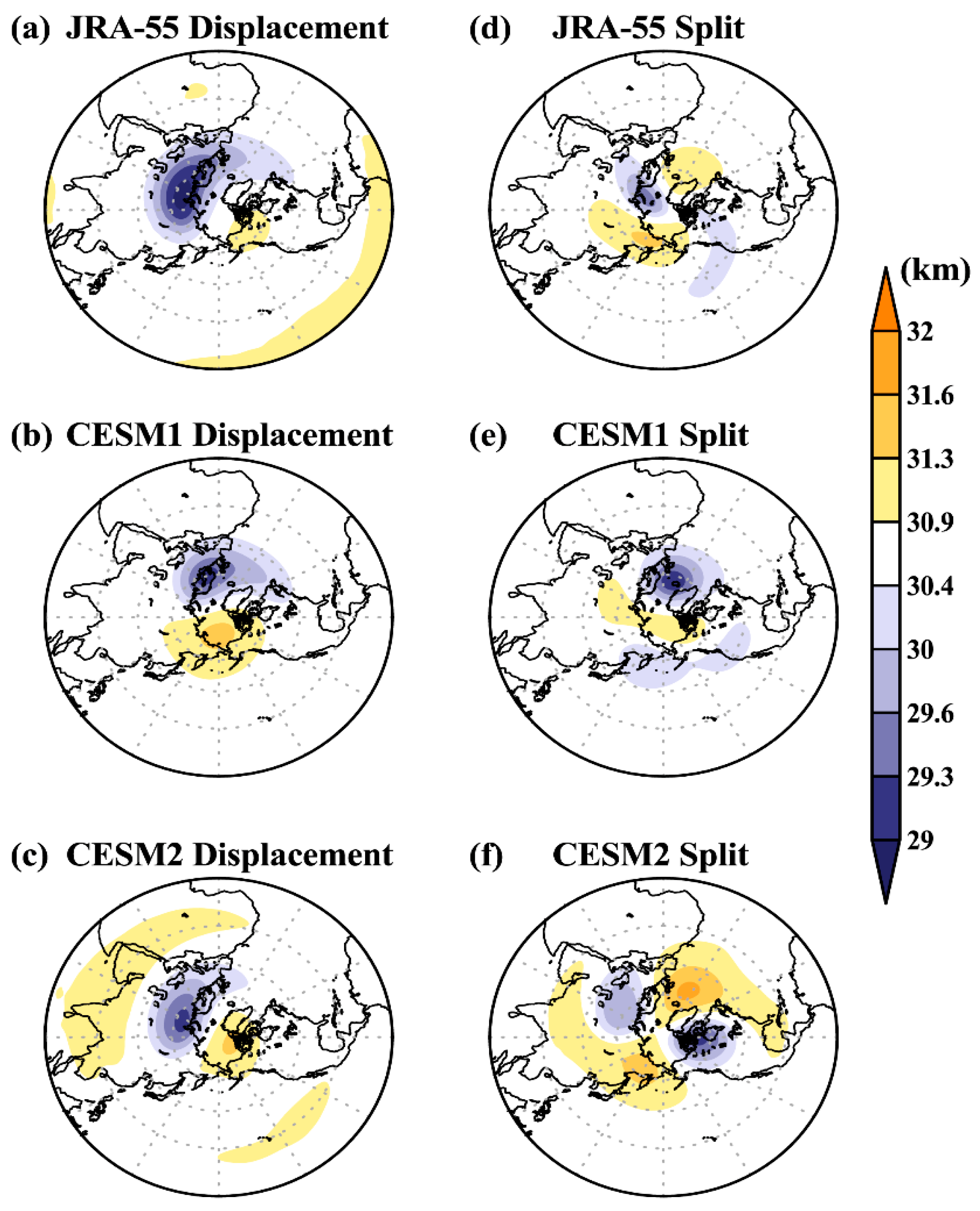
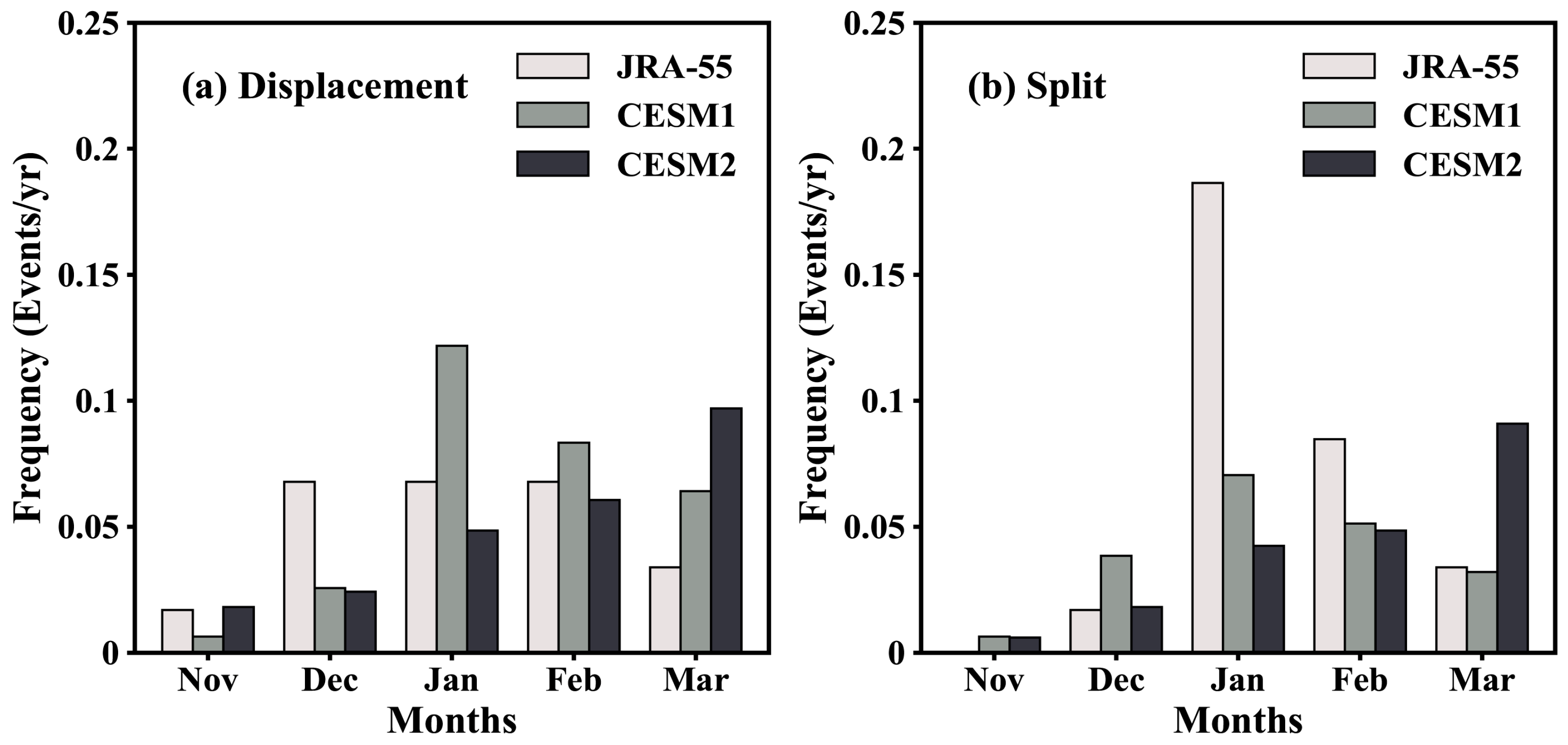
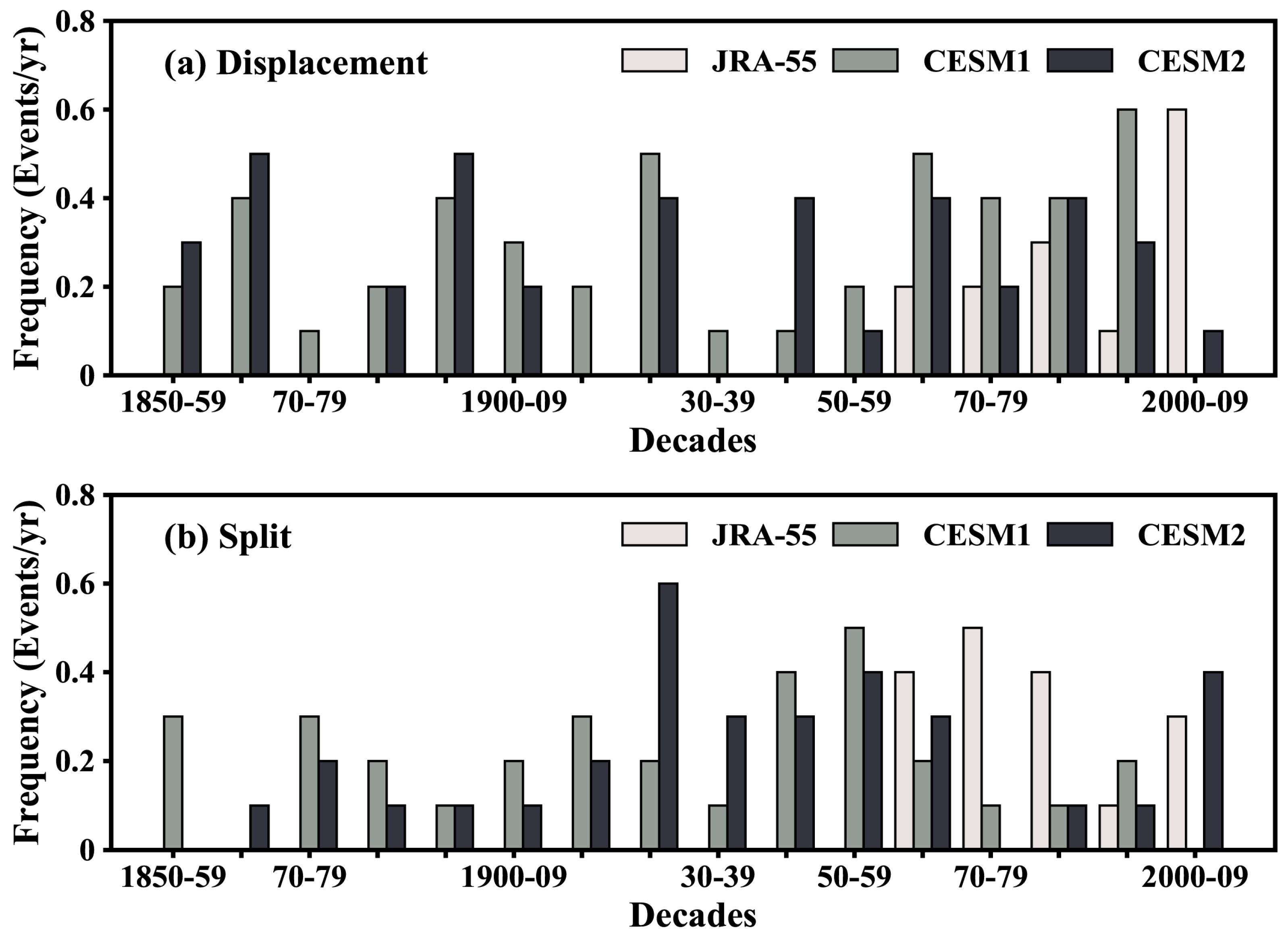
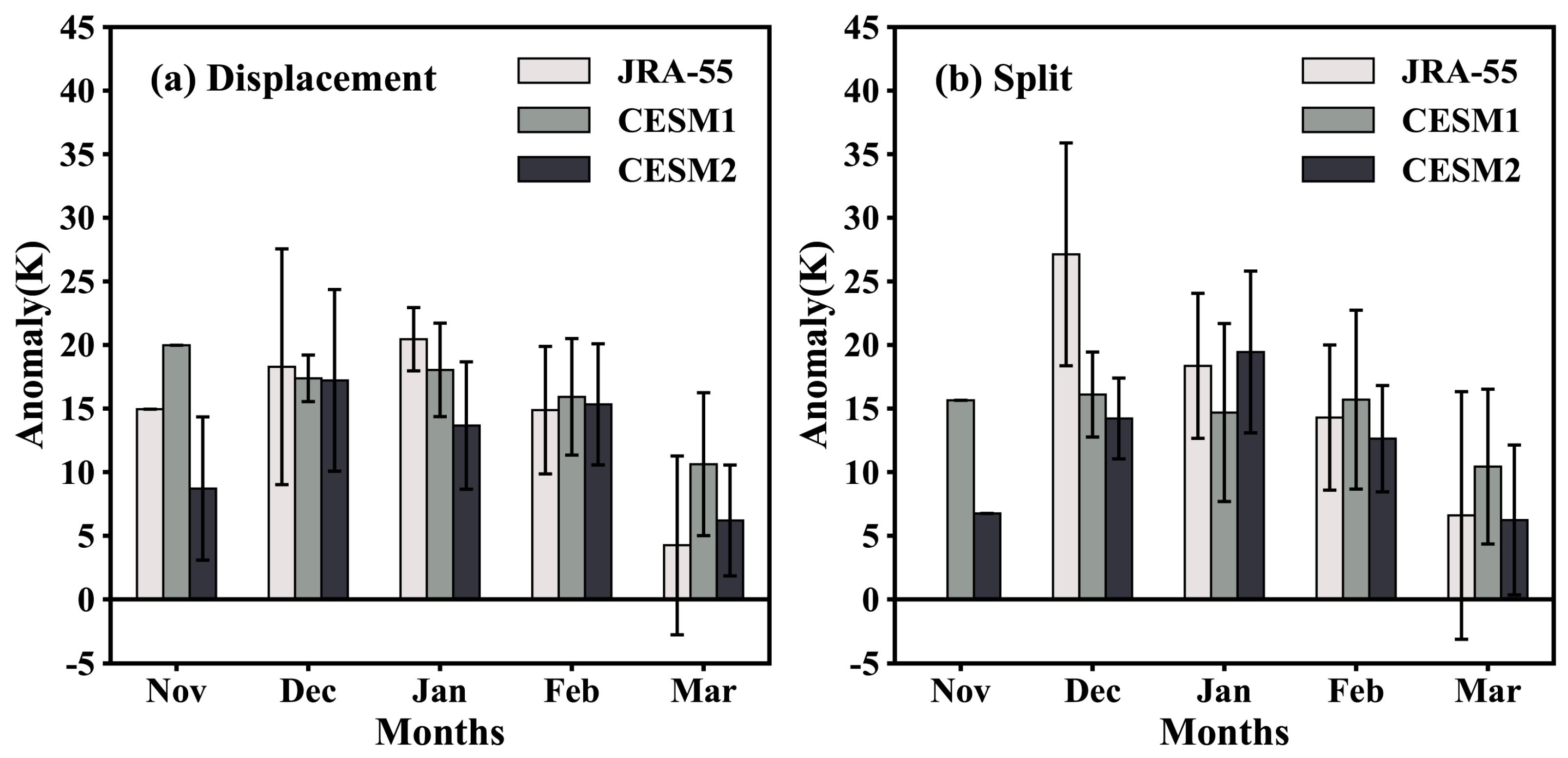
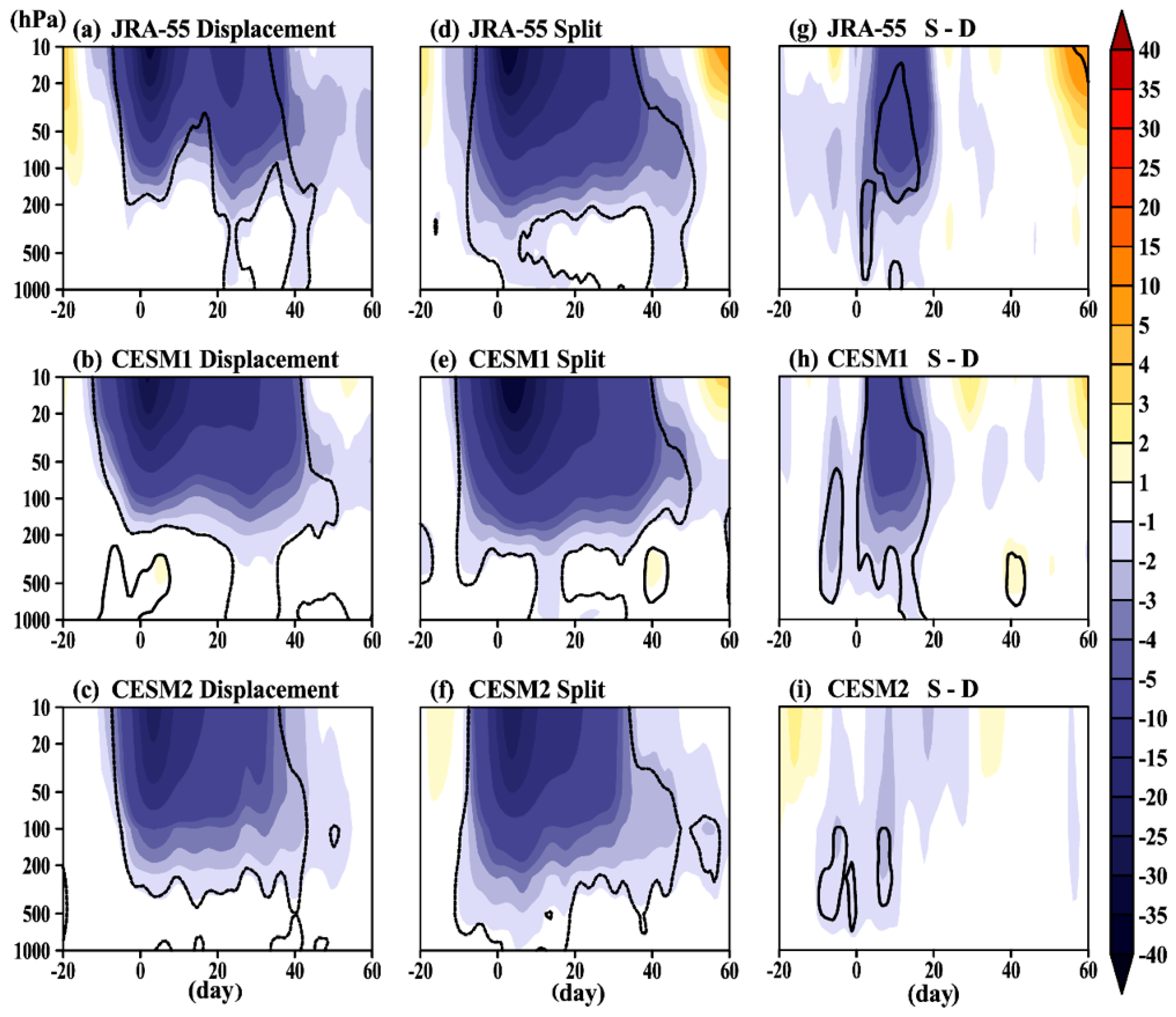
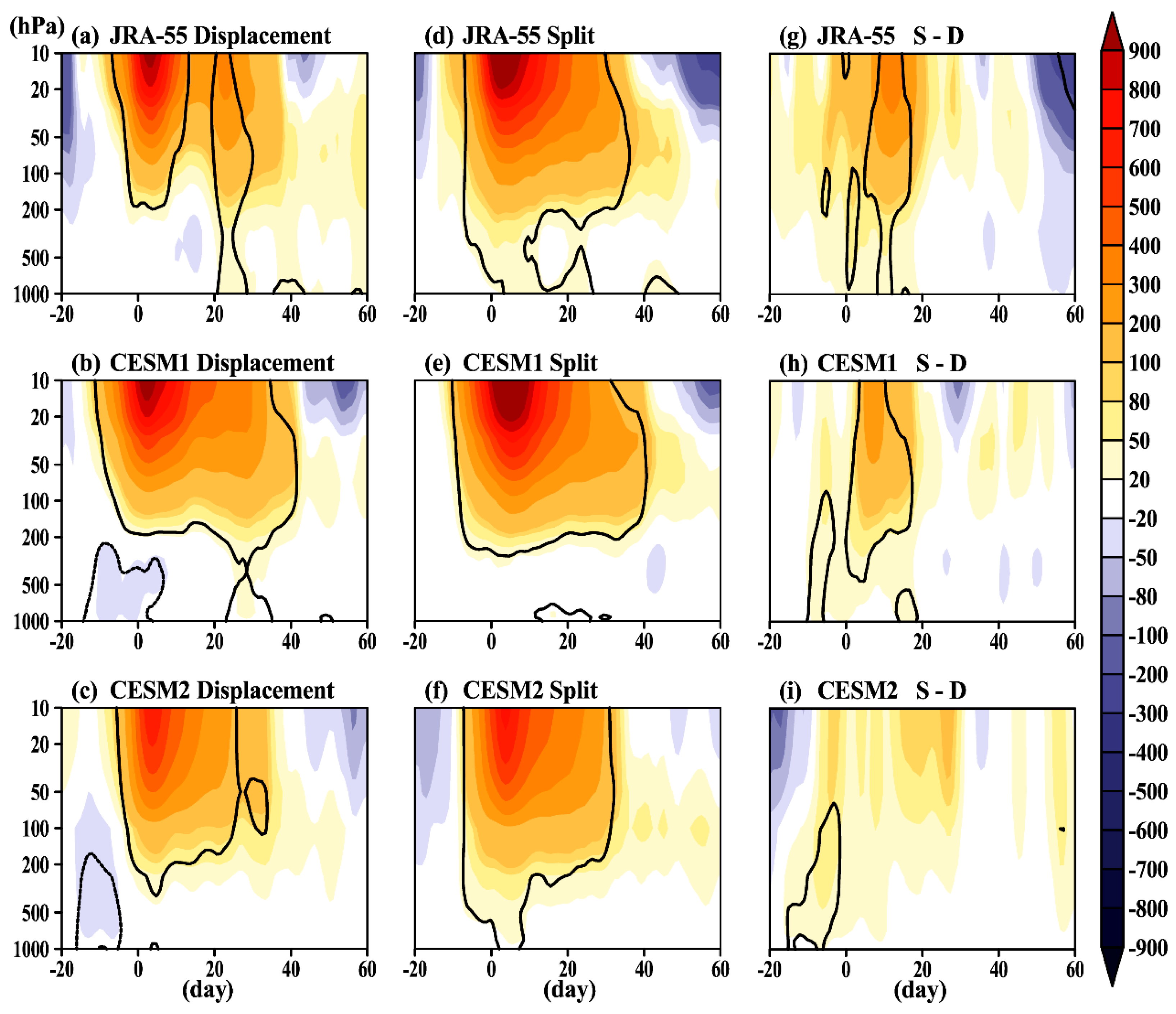
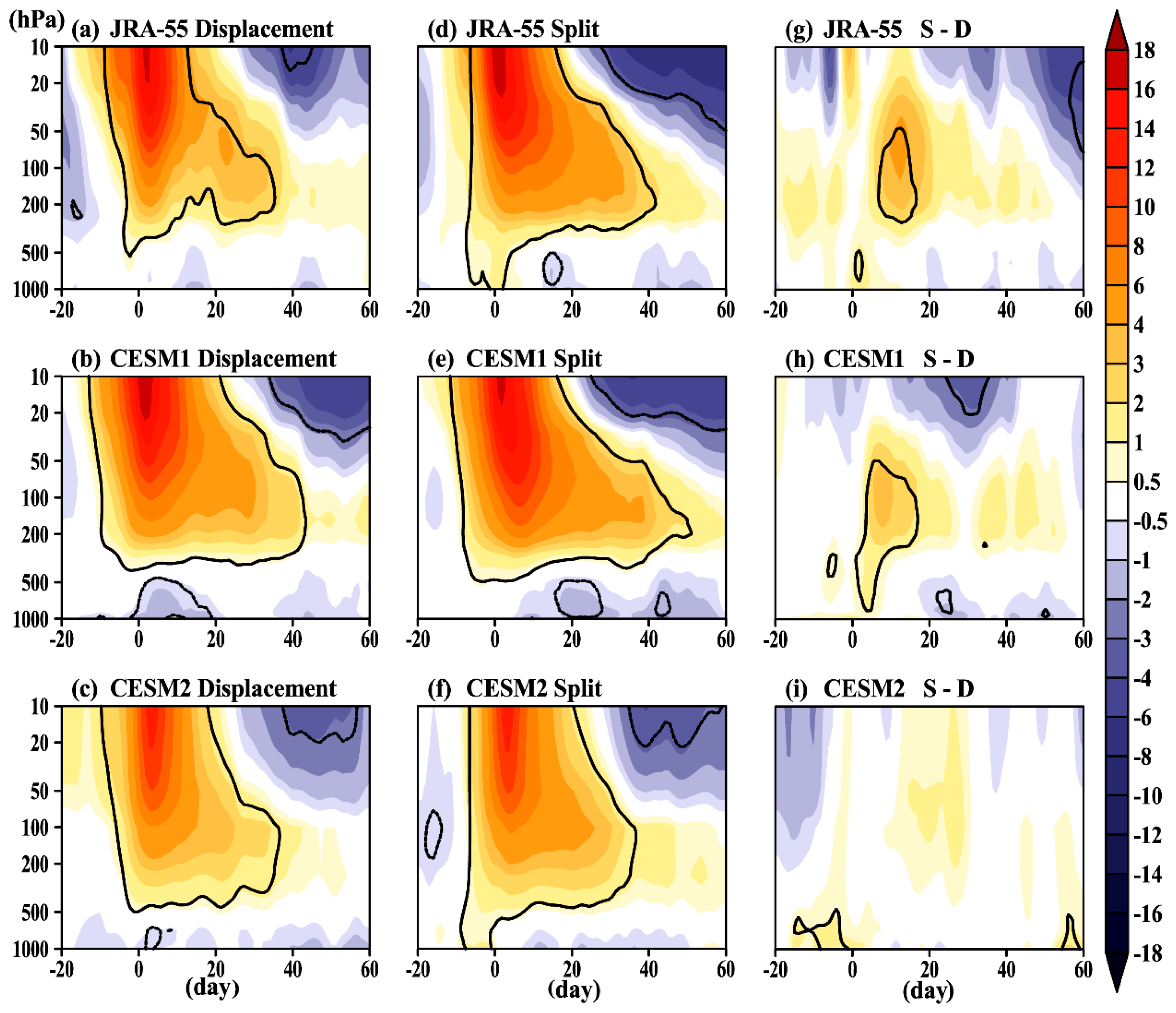
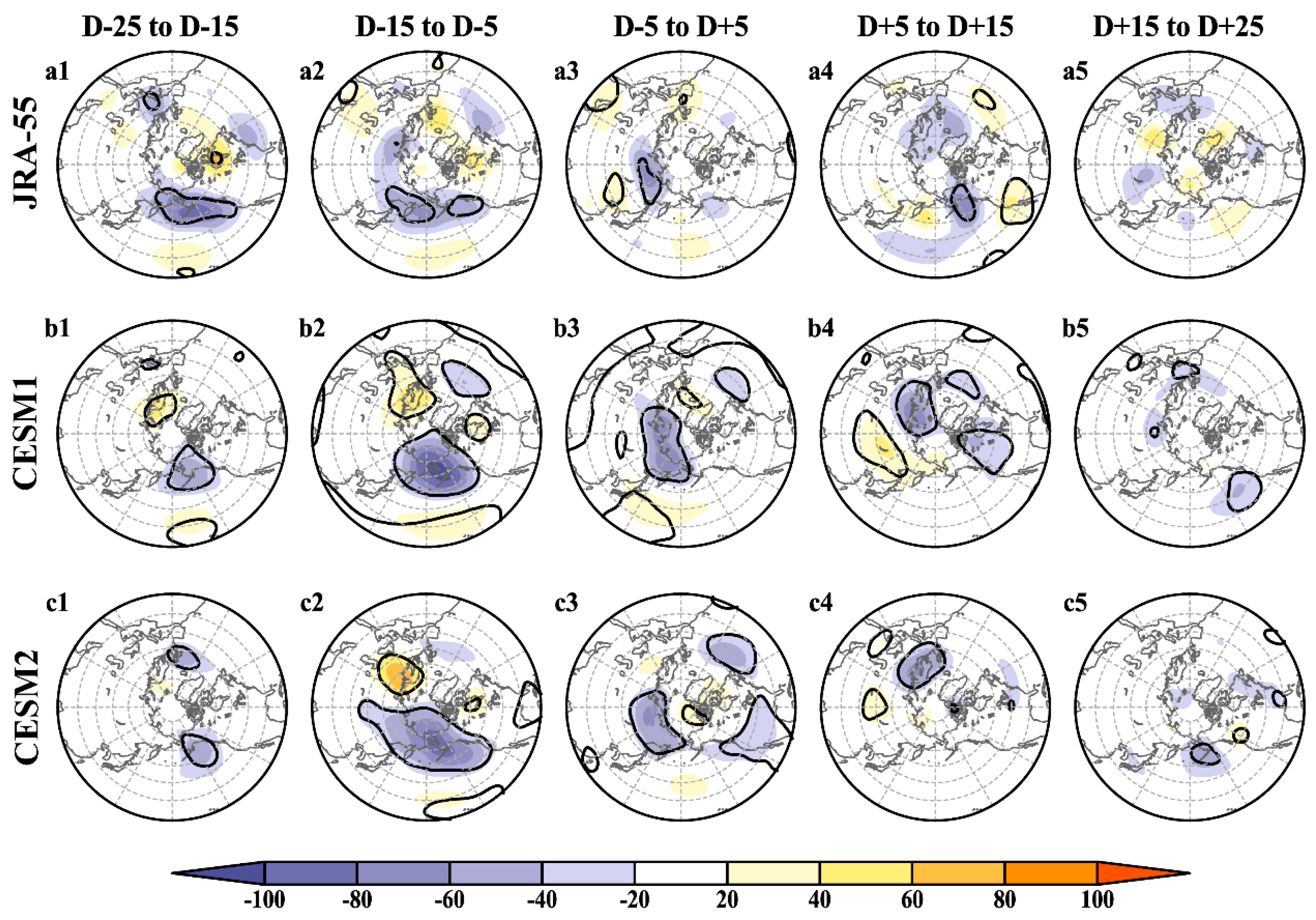
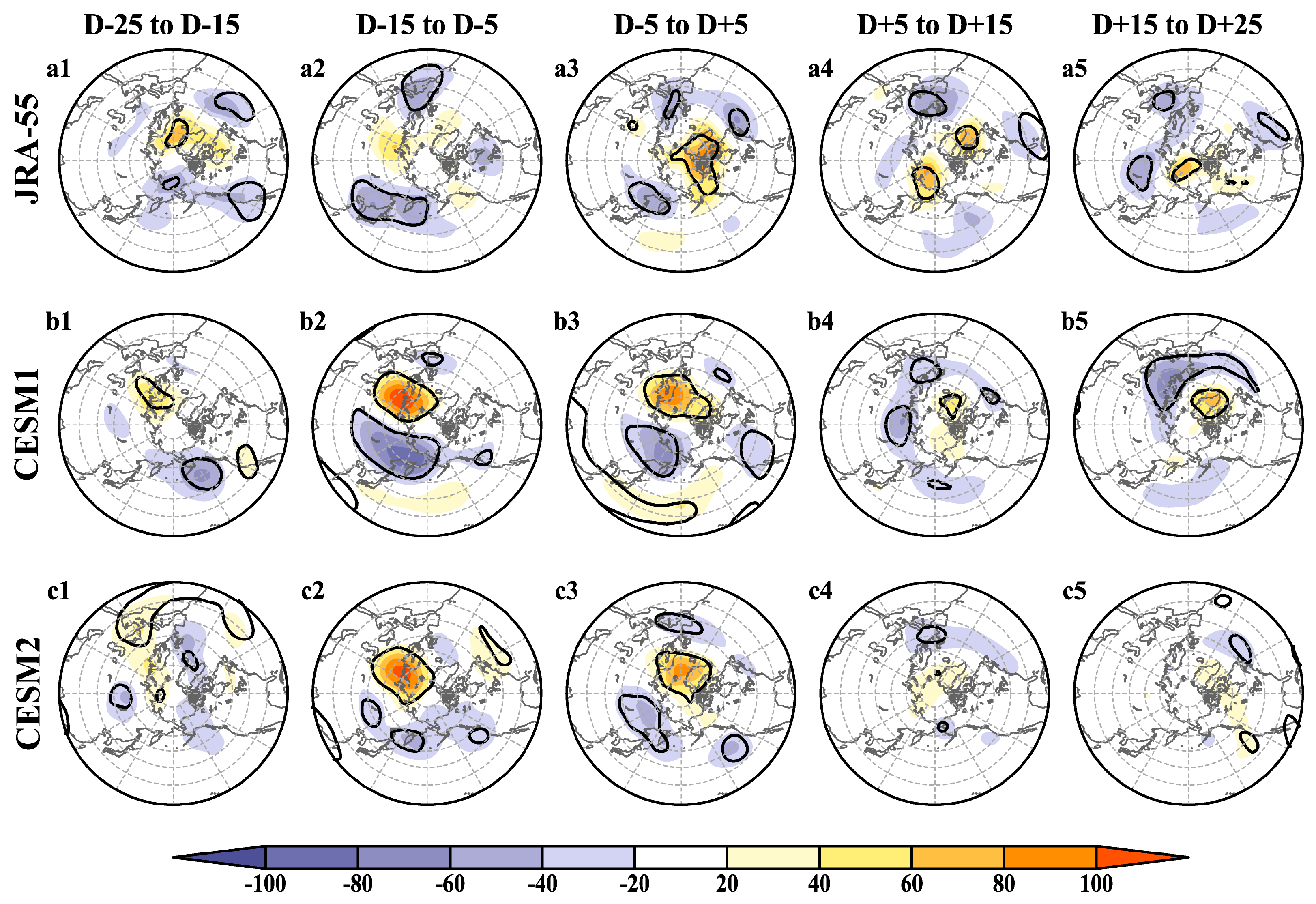
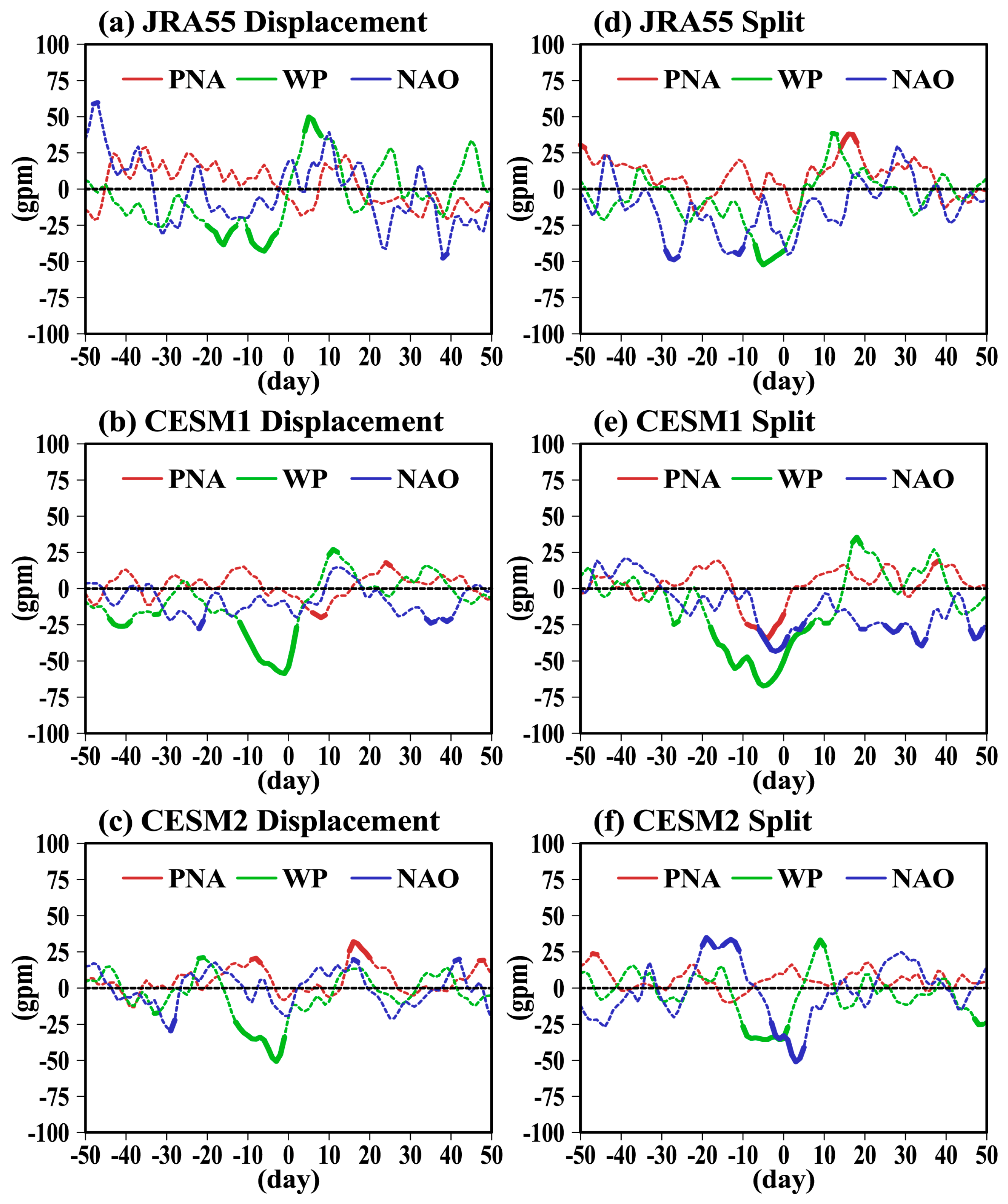
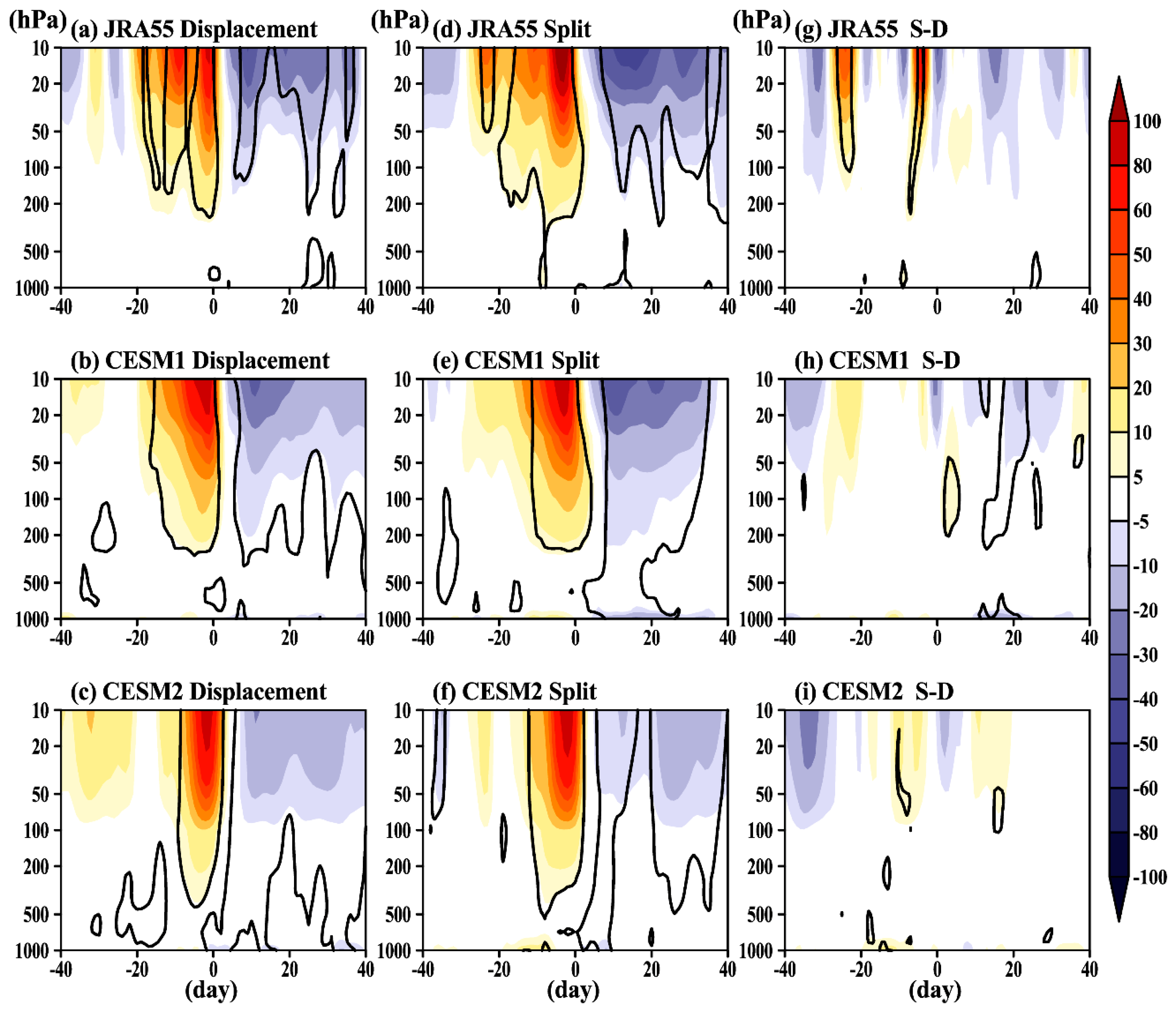
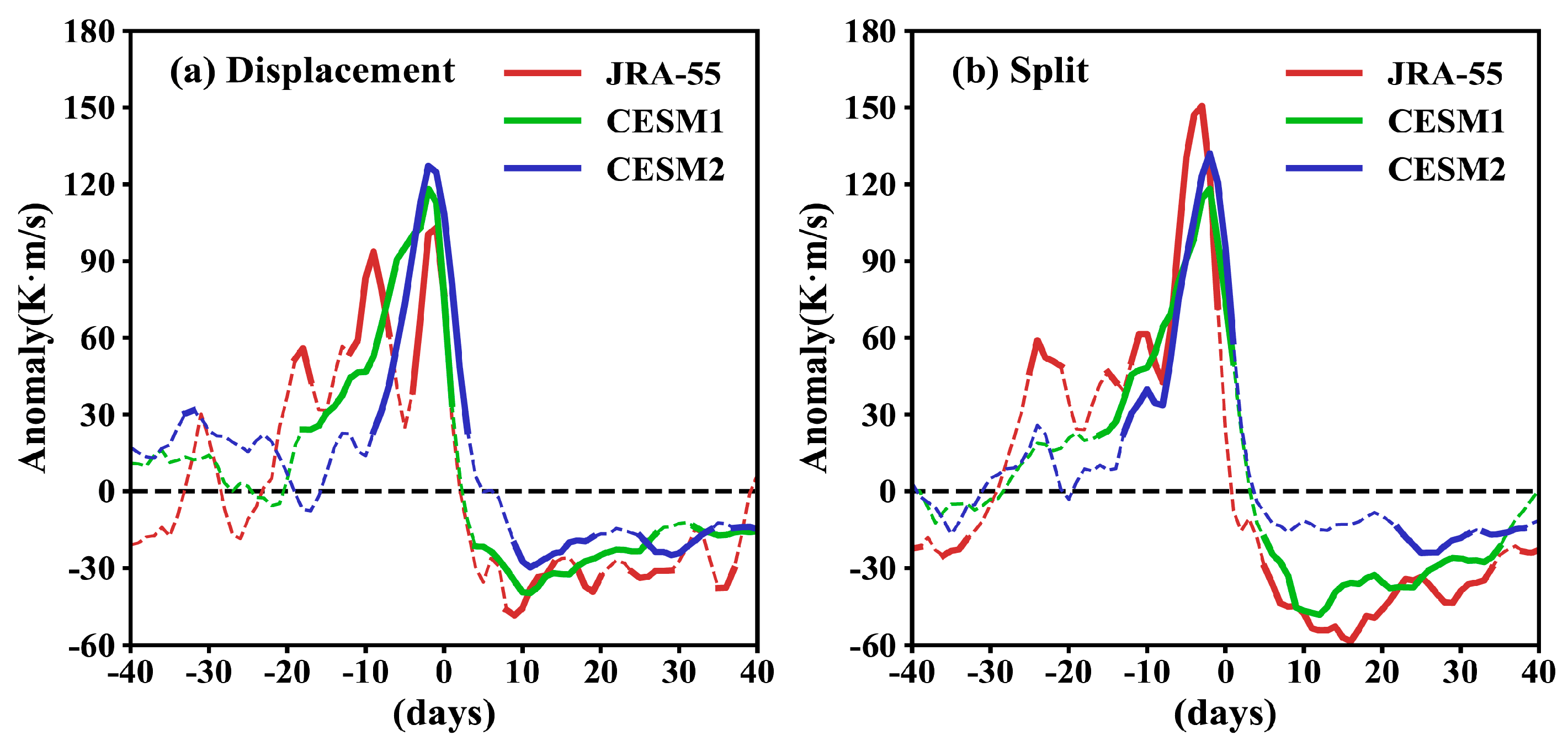
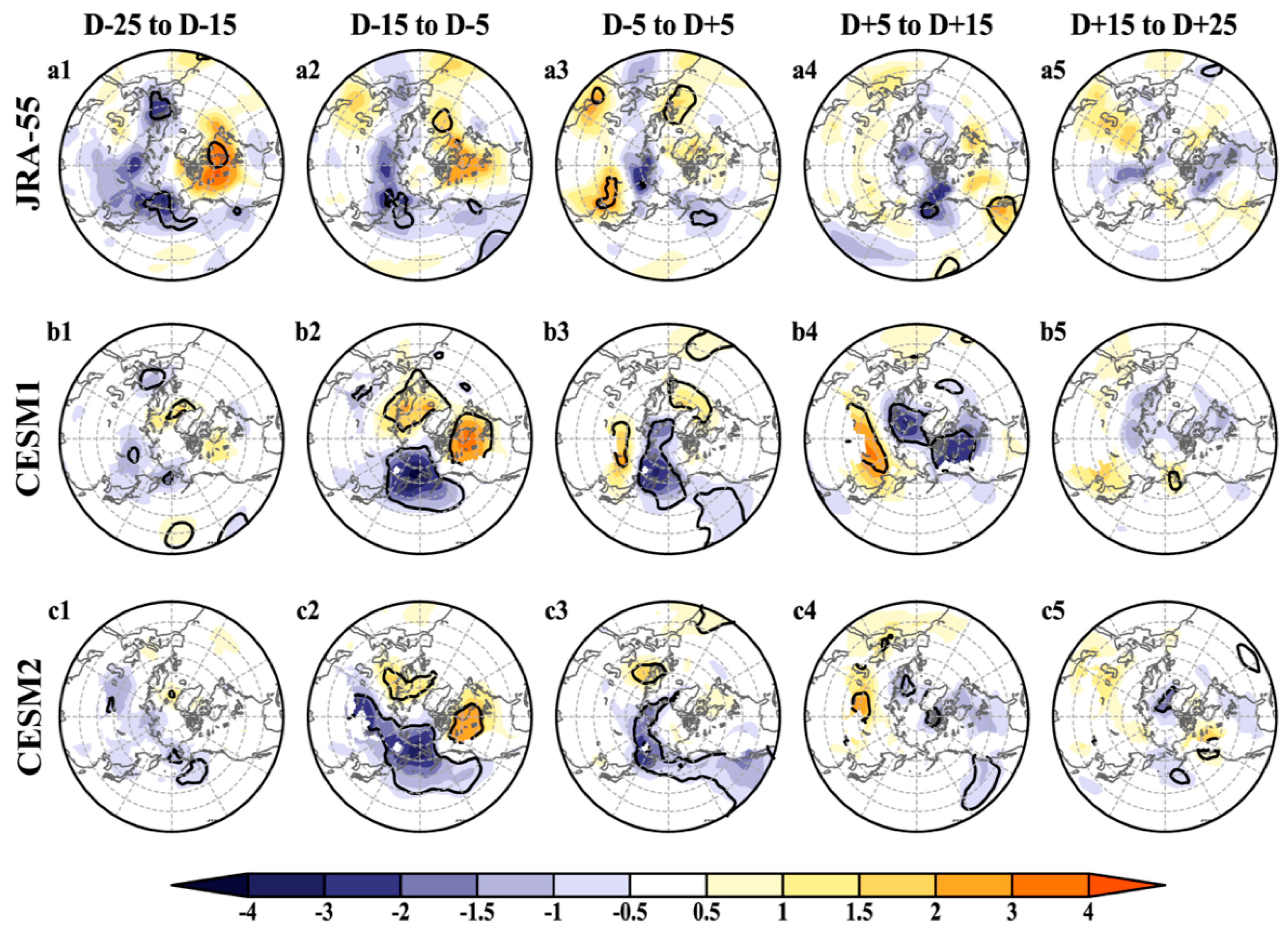
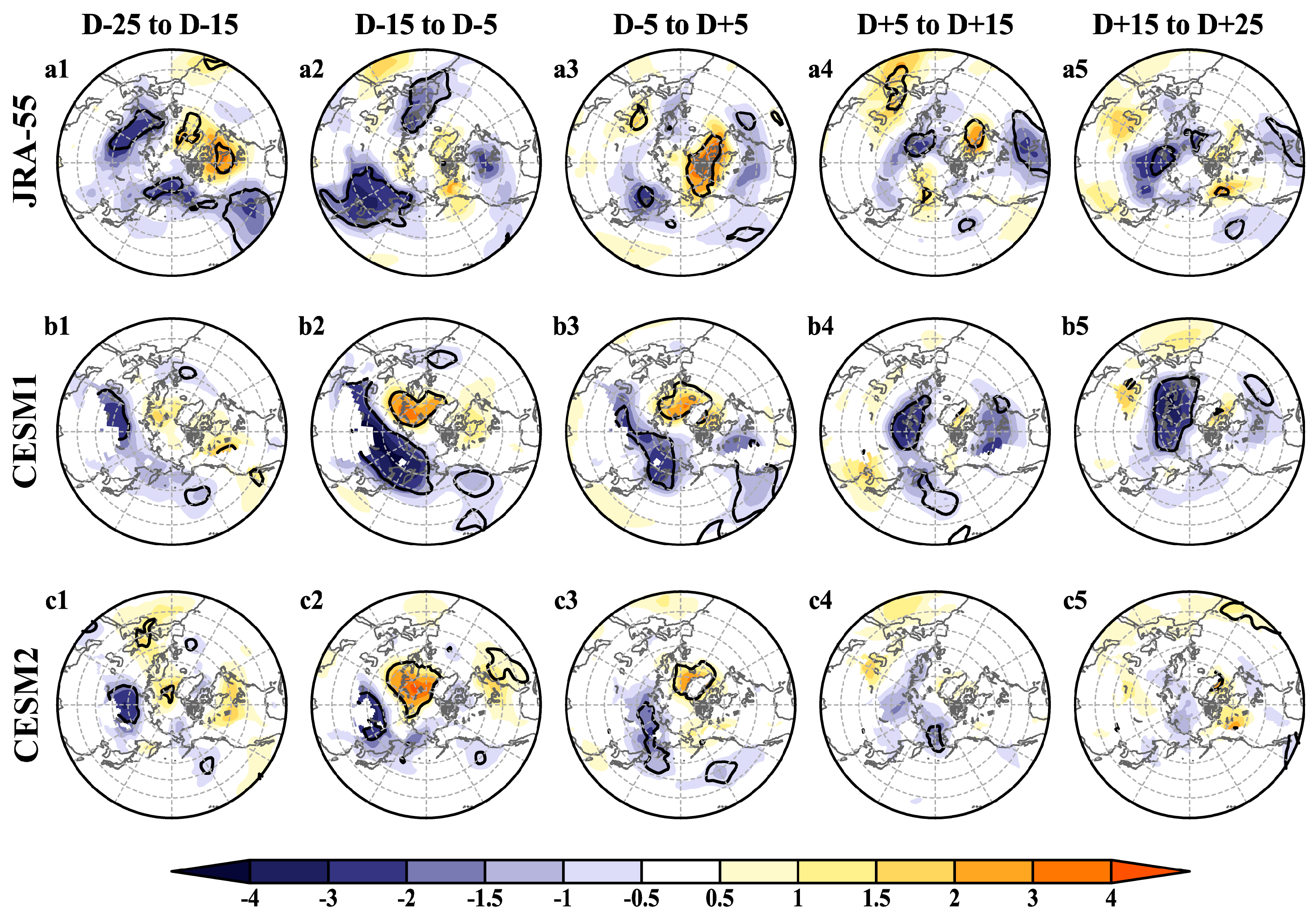
| JRA55 | CESM1-WACCM | CESM2-WACCM | ||
|---|---|---|---|---|
| 17 Jan 1960 - S | 2 Mar 1851 - D | 7 Feb 1930 - D | 25 Feb 1854 - D | 27 Mar 1944 - S |
| 30 Jan 1963 - S | 20 Mar 1853 - S | 18 Jan 1936 - S | 13 Dec 1856 - D | 13 Feb 1945 - S |
| 18 Dec 1965 - D | 29 Dec 1853 - S | 12 Dec 1941 - S | 7 Jan 1858 - D | 10 Mar 1945 - D |
| 23 Feb 1966 - S | 10 Jan 1855 - D | 15 Jan 1945 - S | 2 Mar 1860 - D | 22 Jan 1946 - D |
| 7 Feb 1968 - S | 22 Mar 1855 - S | 3 Dec 1947 - S | 5 Jan 1861 | 25 Feb 1947 - S |
| 29 Nov 1968 - D | 28 Jan 1860 - D | 19 Feb 1948 - S | 29 Jan 1864 - D | 26 Mar 1949 - D |
| 2 Jan 1970 - S | 28 Mar 1862 - D | 28 Jan 1949 - D | 17 Jan 1865 - S | 29 Nov 1950 - S |
| 25 Jan 1970 - S | 15 Jan 1865 - D | 19 Mar 1952 - D | 24 Nov 1865 - D | 28 Jan 1952 - S |
| 18 Jan 1971 - D | 19 Mar 1867 - D | 6 Jan 1953 - S | 29 Dec 1867 - D | 2 Mar 1955 - S |
| 20 Mar 1971 - S | 26 Jan 1874 - S | 18 Mar 1953 - S | 22 Feb 1869 - D | 21 Feb 1956 - D |
| 31 Jan 1973 - S | 13 Jan 1876 - S | 17 Mar 1954 - D | 10 Mar 1871 - S | 24 Feb 1957 - S |
| 9 Jan 1977 - S | 17 Jan 1877 - D | 20 Feb 1955 - S | 15 Mar 1877 - S | 1 Mar 1960 - S |
| 22 Feb 1979 - D | 6 Dec 1877 - S | 24 Jan 1958 - S | 26 Feb 1880 - D | 17 Feb 1961 - D |
| 29 Feb 1980 | 4 Jan 1880 - D | 14 Jan 1959 - S | 27 Mar 1880 - D | 3 Mar 1962 - S |
| 6 Feb 1981 - D | 4 Feb 1880 - S | 21 Feb 1960 - S | 1 Mar 1881 - S | 6 Mar 1963 - D |
| 4 Dec 1981 - D | 19 Feb 1887 - S | 27 Nov 1961 - S | 13 Mar 1891 -S | 6 Mar 1967 - D |
| 1 Jan 1985 - S | 13 Jan 1889 - D | 18 Feb 1963 - D | 10 Feb 1894 - D | 18 Jan 1968 - S |
| 23 Jan 1987 -D | 4 Feb 1889 - S | 31 Jan 1964 - D | 7 Mar 1894 - D | 8 Mar 1969 - D |
| 8 Dec 1987 - S | 3 Mar 1893 - S | 19 Mar 1965 - D | 21 Jan 1896 - D | 18 Mar 1977 - D |
| 14 Mar 1988 -S | 23 Nov 1894 - D | 28 Dec 1966 - D | 29 Nov 1896 -D | 26 Mar 1978 - D |
| 21 Feb 1989 - S | 26 Dec 1896 - D | 7 Feb 1969 - D | 21 Jan 1899 - D | 7 Feb 1981 - D |
| 15 Dec 1998 - D | 24 Jan 1898 - D | 6 Jan 1970 - D | 10 Mar 1902 - D | 18 Mar 1985 - D |
| 26 Feb 1999 - S | 21 Dec 1899 - D | 17 Feb 1971 - D | 26 Feb 1904 - S | 7 Mar 1986 - D |
| 20 Mar 2000 - D | 30 Jan 1900 - S | 9 Mar 1973 - D | 22 Dec 1906 - D | 9 Dec 1986 - S |
| 11 Feb 2001 - S | 22 Mar 1901 - S | 19 Jan 1977 - D | 14 Mar 1912 - S | 26 Nov 1987 - D |
| 31 Dec 2001 - D | 6 Jan 1904 - D | 7 Jan 1979 - S | 14 Feb 1915 - S | 16 Feb 1990 - D |
| 18 Jan 2003 - S | 29 Jan 1906 - D | 4 Feb 1981 - D | 5 Jan 1920 - D | 27 Jan 1991 - S |
| 5 Jan 2004 - D | 26 Jan 1908 - D | 26 Jan 1985 - D | 16 Mar 1921 -S | 16 Mar 1995 - D |
| 21 Jan 2006 - D | 21 Jan 1910 - D | 3 Feb 1986 - S | 28 Feb 1922 - S | 8 Feb 1999 - D |
| 24 Feb 2007 - D | 7 Feb 1912 - S | 2 Mar 1987 - D | 26 Jan 1924 - D | 3 Dec 1999 |
| 22 Feb 2008 - D | 10 Feb 1914 - S | 27 Feb 1989 - D | 18 Jan 1925 - S | 3 Feb 2001 - S |
| 24 Jan 2009 - S | 9 Feb 1915 - D | 26 Mar 1993 - D | 4 Mar 1926 - S | 16 Mar 2004 - D |
| 9 Feb 2010 - S | 24 Dec 1917 - S | 12 Jan 1994 - S | 10 Dec 1926 -D | 7 Mar 2006 - S |
| 24 Mar 2010 -D | 18 Feb 1920 - D | 25 Feb 1994 - D | 4 Feb 1927 - D | 26 Jan 2007 - S |
| 7 Jan 2013 - S | 20 Mar 1920 - D | 18 Feb 1995 - D | 25 Mar 1928 -S | 23 Mar 2008 - S |
| 16 Dec 1920 - D | 6 Mar 1997 - D | 3 Feb 1929 - S | 20 Mar 2010 - D | |
| 22 Jan 1922 - D | 8 Feb 1998 - D | 24 Dec 1930 - S | 25 Jan 2013 - S | |
| 8 Dec 1924 - S | 10 Jan 1999 - D | 18 Dec 1932 - S | ||
| 19 Mar 1928 - S | 9 Feb 2003 - D | 1 Mar 1934 - S | ||
| 1 Jan 1929 - D | 14 Jan 2005 - S | 27 Jan 1940 - D | ||
© 2019 by the authors. Licensee MDPI, Basel, Switzerland. This article is an open access article distributed under the terms and conditions of the Creative Commons Attribution (CC BY) license (http://creativecommons.org/licenses/by/4.0/).
Share and Cite
Liu, S.-M.; Chen, Y.-H.; Rao, J.; Cao, C.; Li, S.-Y.; Ma, M.-H.; Wang, Y.-B. Parallel Comparison of Major Sudden Stratospheric Warming Events in CESM1-WACCM and CESM2-WACCM. Atmosphere 2019, 10, 679. https://doi.org/10.3390/atmos10110679
Liu S-M, Chen Y-H, Rao J, Cao C, Li S-Y, Ma M-H, Wang Y-B. Parallel Comparison of Major Sudden Stratospheric Warming Events in CESM1-WACCM and CESM2-WACCM. Atmosphere. 2019; 10(11):679. https://doi.org/10.3390/atmos10110679
Chicago/Turabian StyleLiu, Si-Ming, Yuan-Hao Chen, Jian Rao, Can Cao, Si-Yu Li, Mu-Han Ma, and Yao-Bin Wang. 2019. "Parallel Comparison of Major Sudden Stratospheric Warming Events in CESM1-WACCM and CESM2-WACCM" Atmosphere 10, no. 11: 679. https://doi.org/10.3390/atmos10110679
APA StyleLiu, S.-M., Chen, Y.-H., Rao, J., Cao, C., Li, S.-Y., Ma, M.-H., & Wang, Y.-B. (2019). Parallel Comparison of Major Sudden Stratospheric Warming Events in CESM1-WACCM and CESM2-WACCM. Atmosphere, 10(11), 679. https://doi.org/10.3390/atmos10110679






